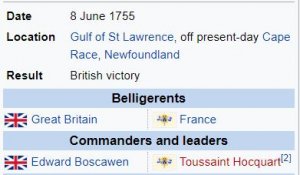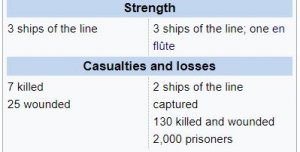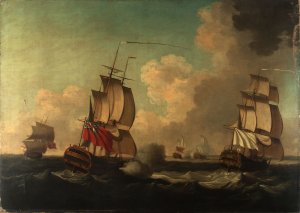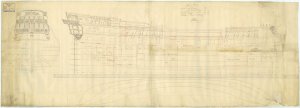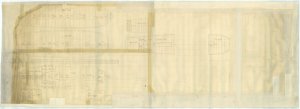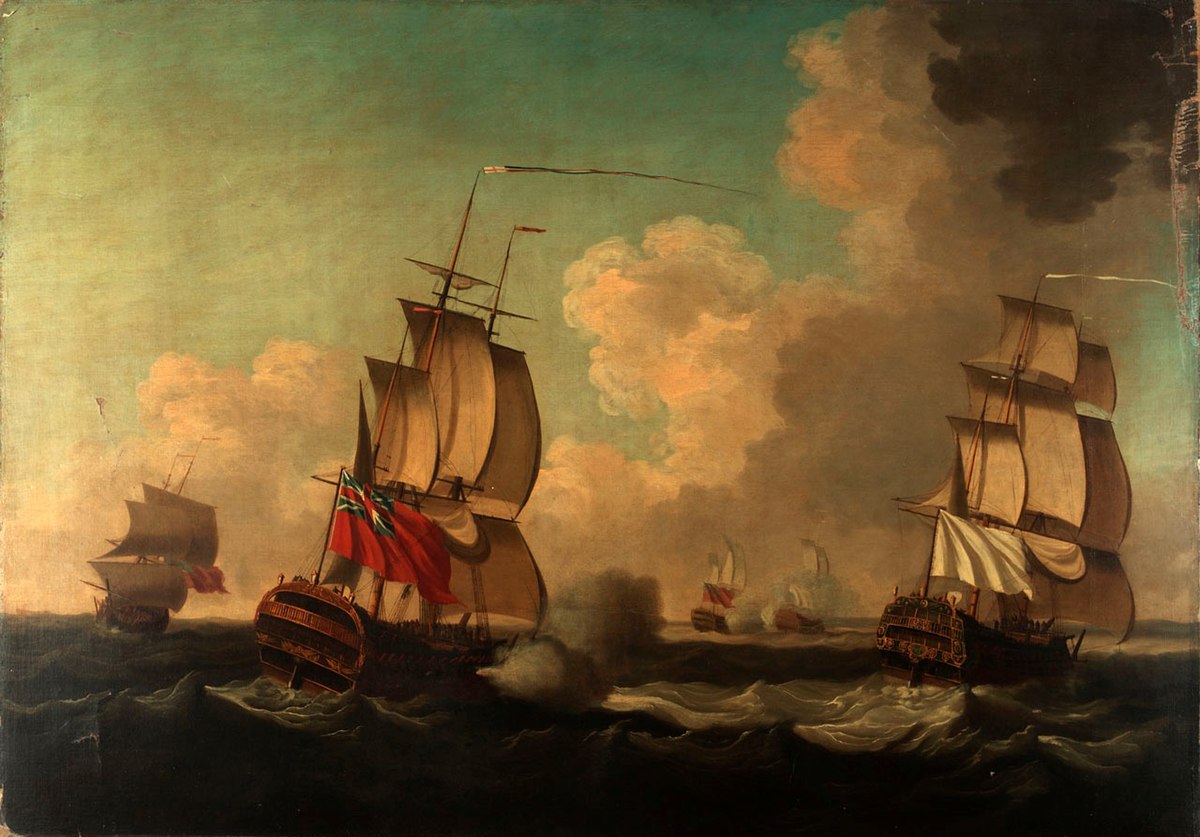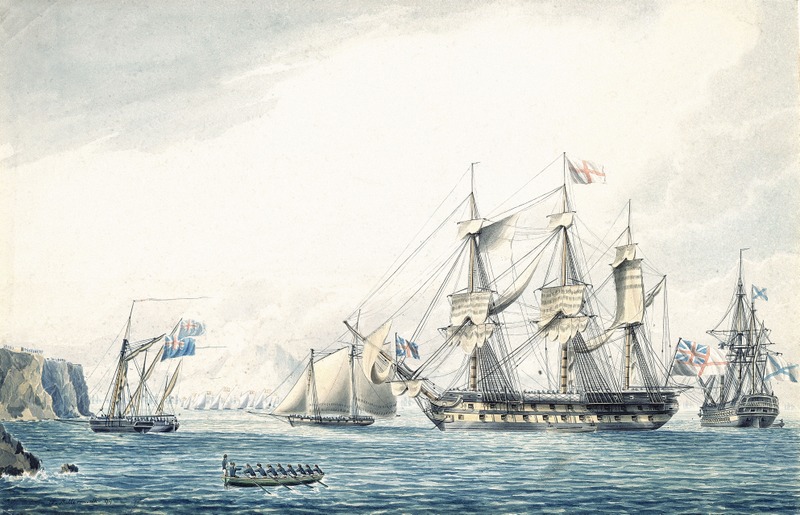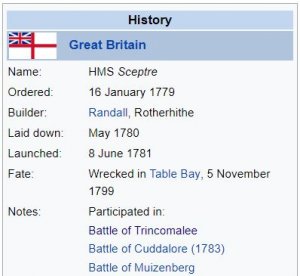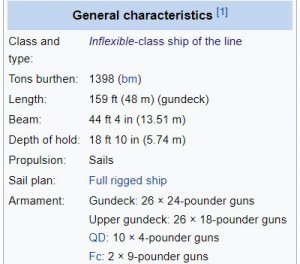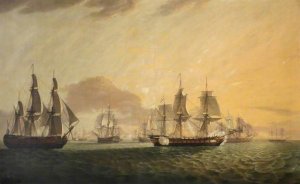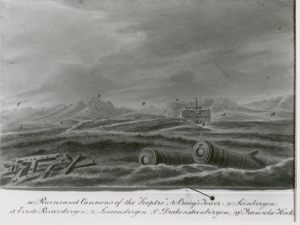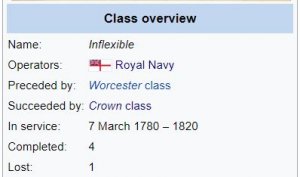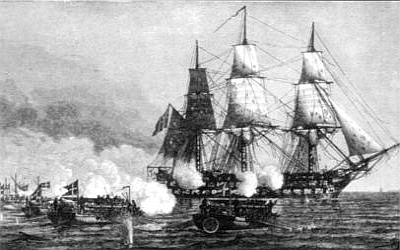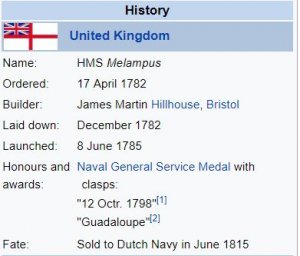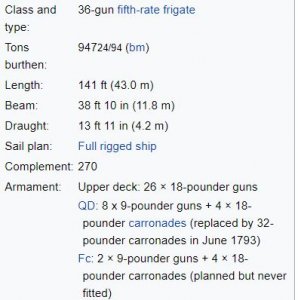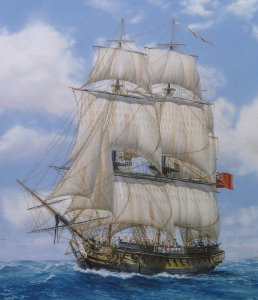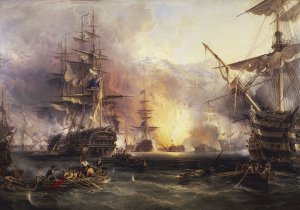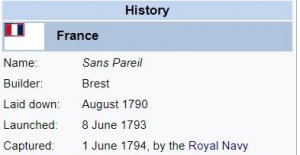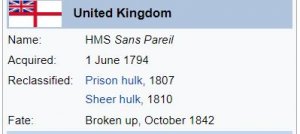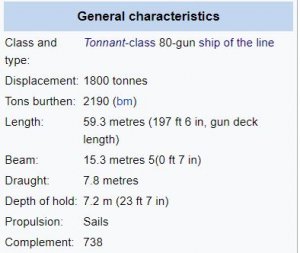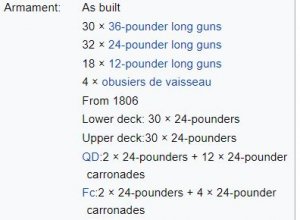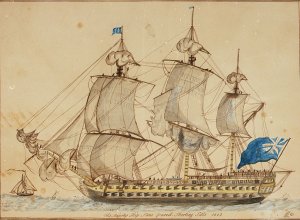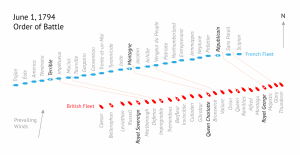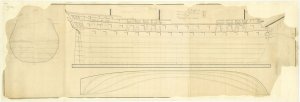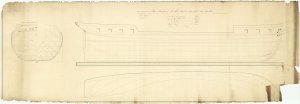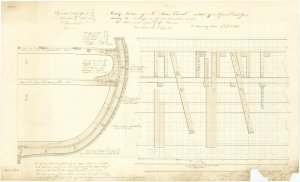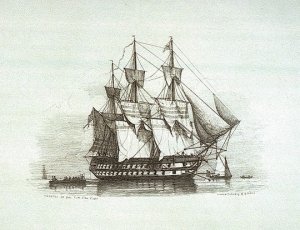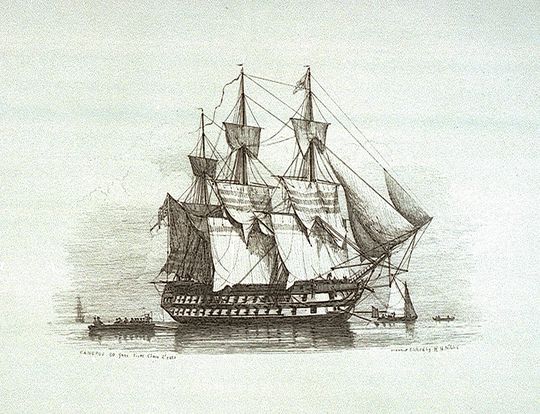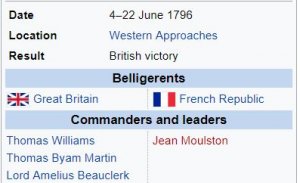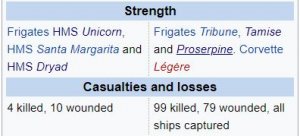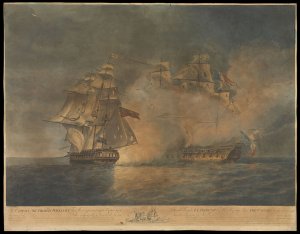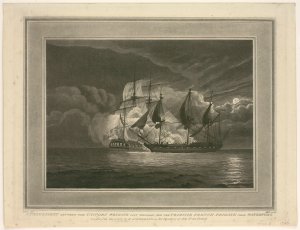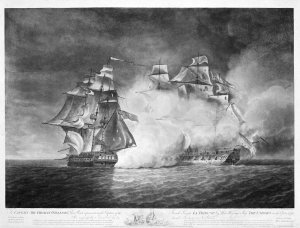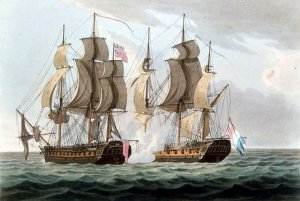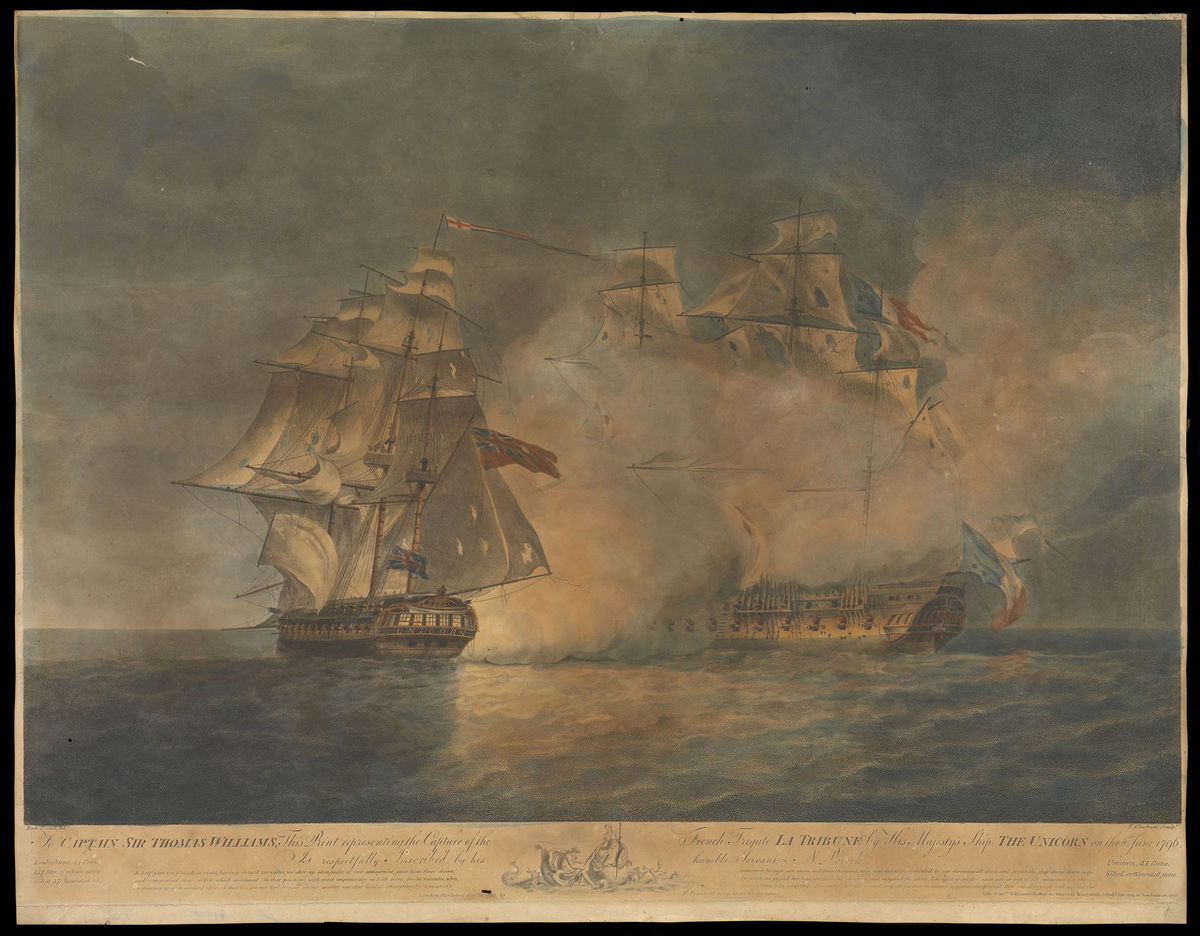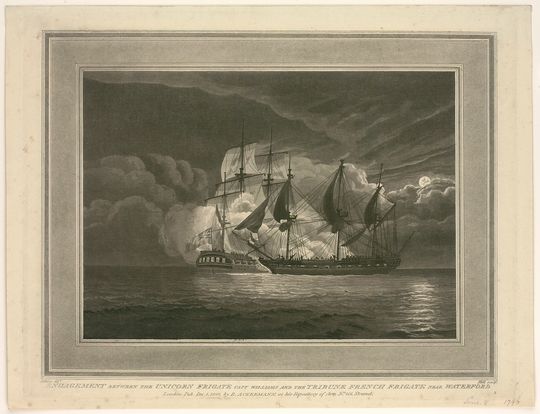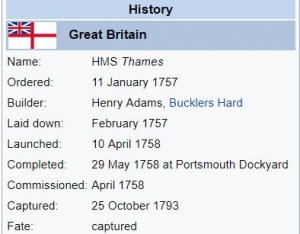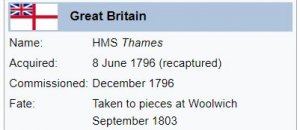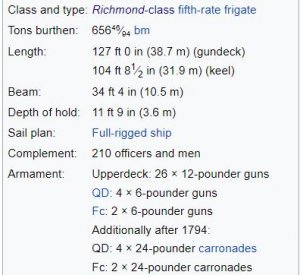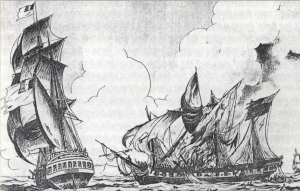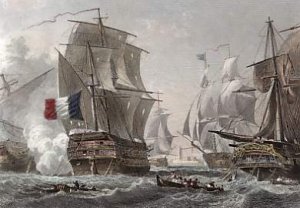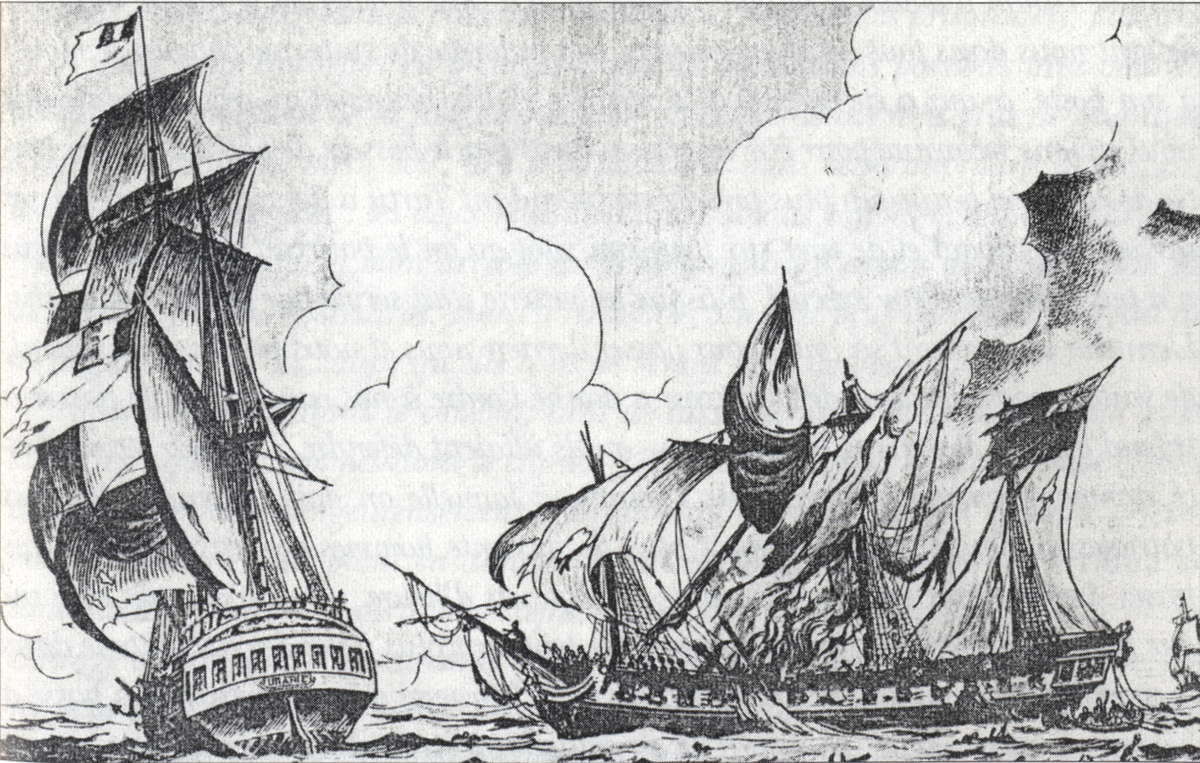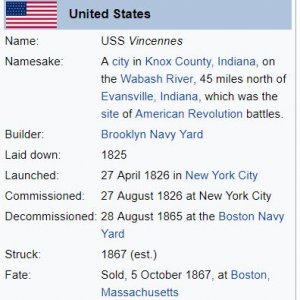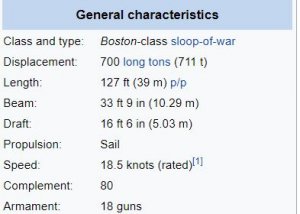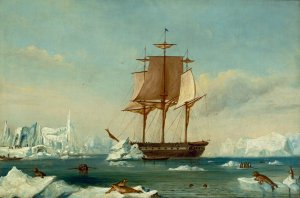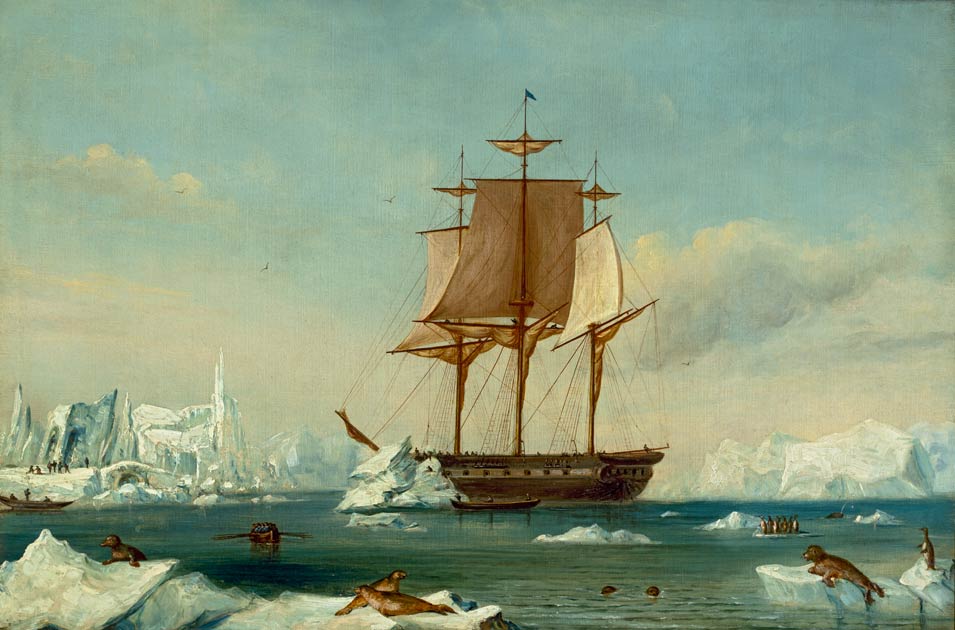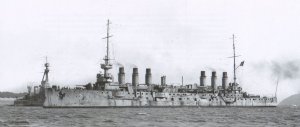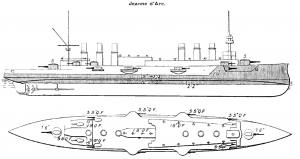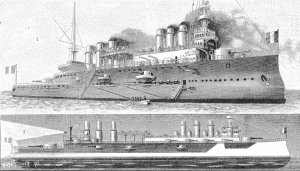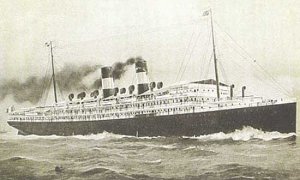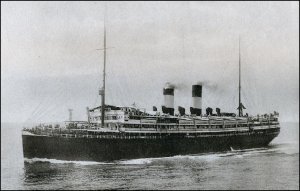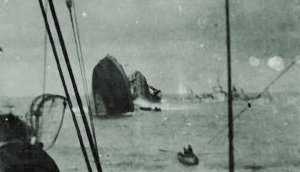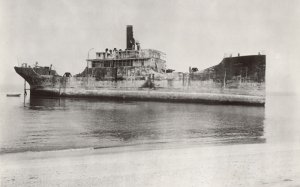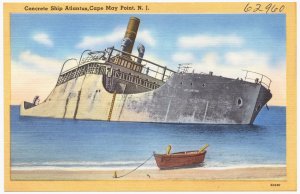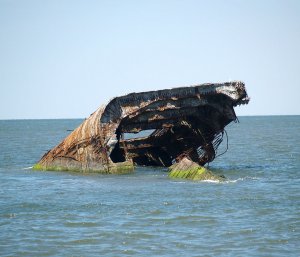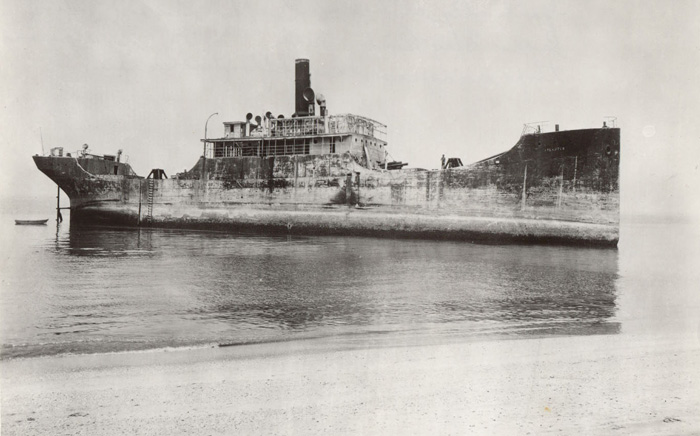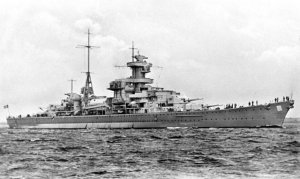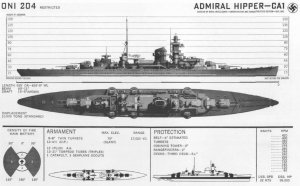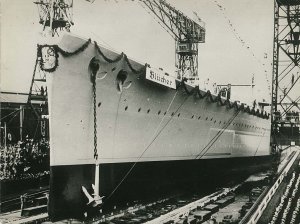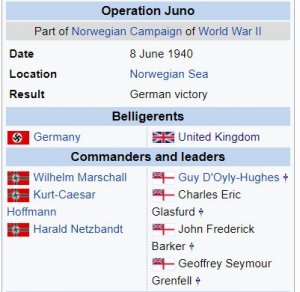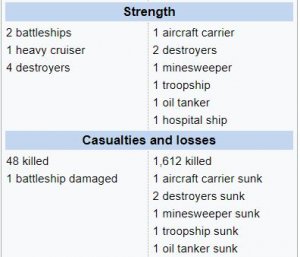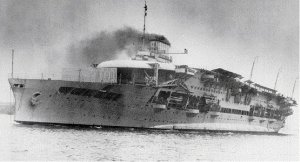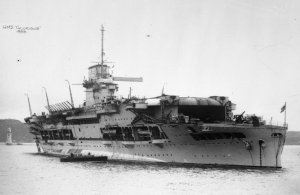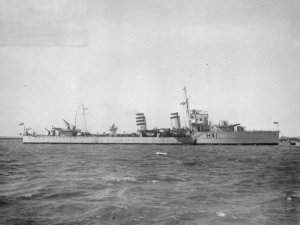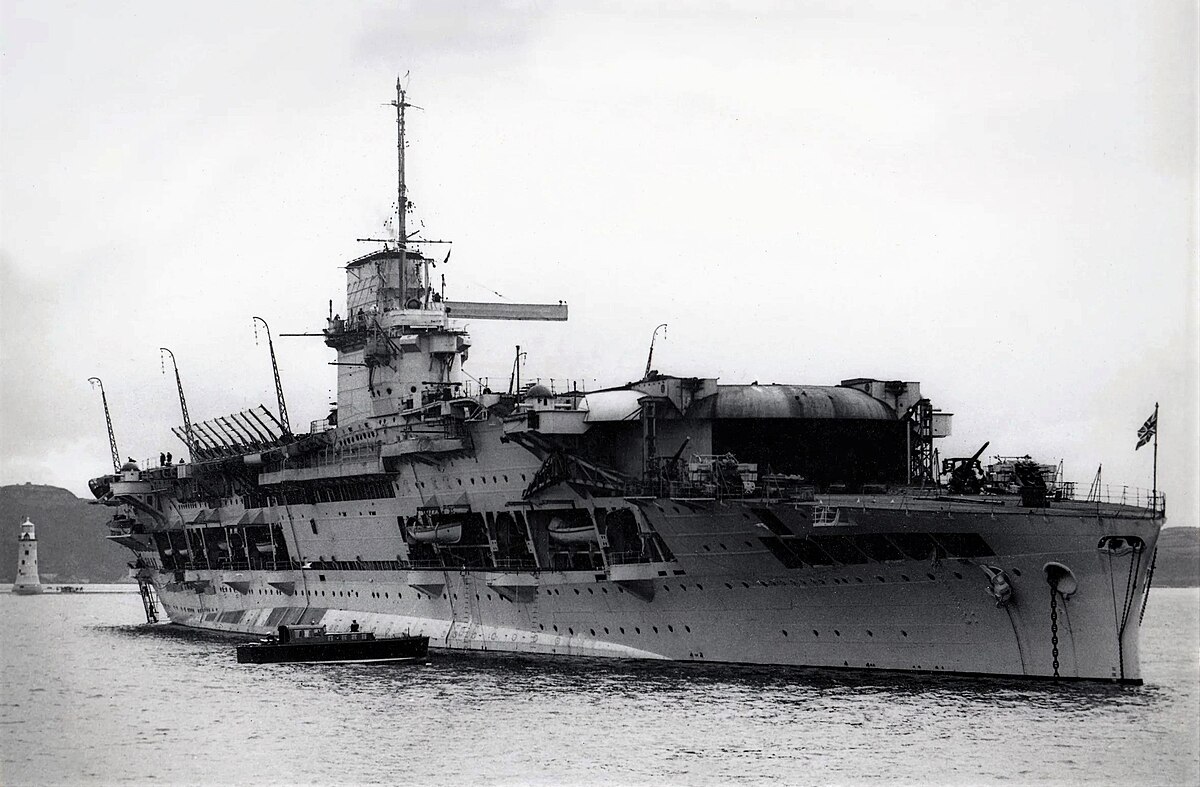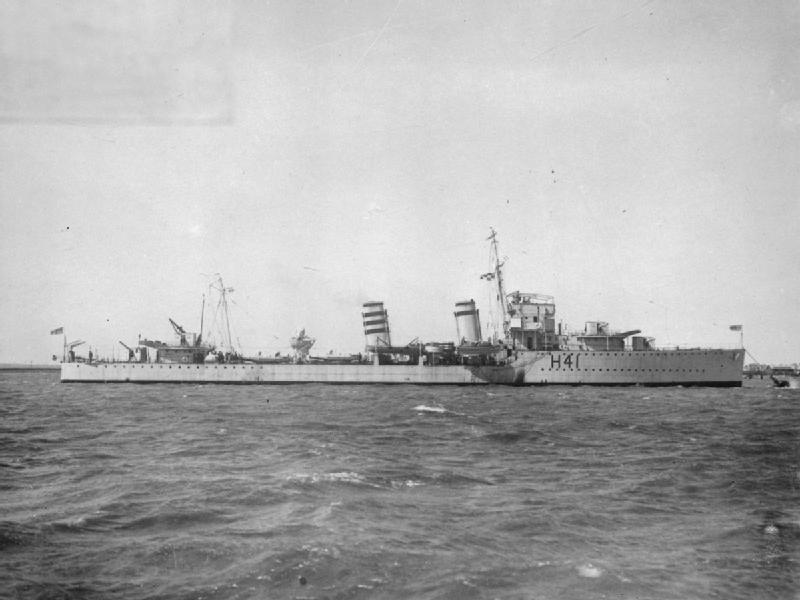Today in Naval History - Naval / Maritime Events in History
8 June 1781 – Launch of HMS Argo, a 44-gun fifth-rate Roebuck-class ship of the Royal Navy, from Howdon Dock.
HMS Argo was a 44-gun
fifth-rate Roebuck-class ship of the
Royal Navy. She was launched in 1781 from Howdon Dock. The French captured her in 1783, but 36 hours later the British recaptured her. She then distinguished herself in the French Revolutionary Wars by capturing several prizes, though she did not participate in any major actions. She also served in the Napoleonic Wars. She was sold in 1816.
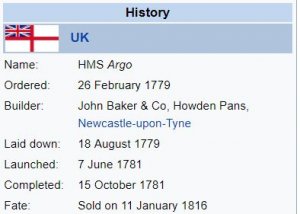
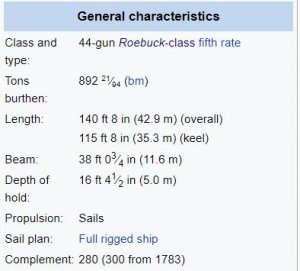
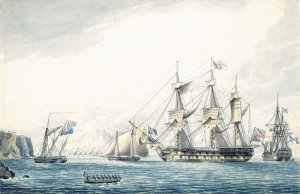 Baltic
Argo
Baltic
Argo was commissioned in March 1781 under Captain John Butchart. On 29 October
Argo sailed for the Baltic with
Albemarle, under the command of Captain Horatio Nelson and
Enterprise, arriving at Elsinor on 4 November. On 8 December the squadron, now under the command of Captain Douglas in
Sampson, escorted a convoy of 280 vessels to Britain, arriving on 22 December.
Gold Coast
Early in 1782,
Argo joined Captain
Thomas Shirley in the 50-gun ship
Leander and the sloop-of-war
Alligator off the Dutch Gold Coast. Britain was at war with The Netherlands and before
Argo arrived Shirley captured the small Dutch forts at Mouri (Fort Nassau - 20 guns), Kormantin (Courmantyne or
Fort Amsterdam - 32 guns),
Apam (Fort Lijdzaamheid or Fort Patience - 22 guns), Senya Beraku (Berku, or Fort Barracco, or Fort Goede Hoop - 18 guns), and Accra (Fort Crêvecoeur or Ussher Fort - 32 guns).
Argo provided a landing party of 50 men who assisted Governor Mills to take Komenda (Fort Komenda).
Capture and recapture
In 1782
Argo was on her passage to the West Indies under Captain Butchart when she captured the French ship
Dauphin, nominally of 64 guns but armed
en flute and so sailing with only 26 guns mounted.
Dauphin had a cargo of military stores and provisions, some brass cannons and mortars, and two hundred soldiers, all bound for Martinique.
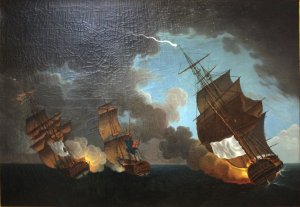 Battle between the French frigates
Battle between the French frigates Nymphe
, Amphitrite
, and the 44-gun two-decker HMS Argo
, 17 February 1783, by
Auguste-Louis de Rossel de Cercy.
Governor Thomas Shirley of the Leeward Islands had
Argo carry him to Tortola where he had official business.
Argo stayed there three weeks until Shirley was ready to return to Antigua. The French found out about this and sent the French 36-gun frigate
Nymphe and the 32-gun
Amphitrite to intercept him.
On 16 February 1783,
Argo and the two French frigates met. After a five-hour action they captured her. Not only did they out gun
Argo, but the sea was so rough that she could not open her lower ports.
Argo had lost thirteen men killed and had suffered a number of wounded, as well as having suffered damage to her masts and rigging. Governor Shirley had stayed on deck throughout the engagement.
About 36 hours later, the 74-gun
third rate HMS
Invincible, under Captain Charles Saxton was coming from Jamaica when she encountered the two French frigates and their prize,
Argo. The frigates fled, leaving
Invincible to recapture
Argo. Captain J. Douglas briefly took command.
After a court martial acquitted her officers, Admiral Sir Hugh Pigot reappointed them. Then Captain J. Douglas briefly took command. She returned to England after the Peace of Paris (1783) and was paid off in April 1784.
Argo underwent repairs at Sheerness between July 1785 and October 1786. She then was fitted as a troopship at Chatham from about June 1790 to April 1791. She was recommissioned in February 1791 under Commander Sandford Tatham, who sailed her for Halifax on 11 May.
Argo was paid off in June 1792.
French Revolutionary Wars
Captain William Clarke recommissioned
Argo in May 1793. Captain Richard Rundle Burgess (or Burges) replaced him in February 1795.
In September 1795,
Argo was part of the force escorting 63 merchants of the Levant convoy from Gibraltar. The other escorts were the 74-gun ships
HMS Fortitude and HMS
Bedford, the 32-gun frigates HMS
Juno and HMS
Lutine, the fireship HMS
Tisiphone, and the recently captured
Censeur. The convoy called at
Gibraltar on 25 September, at which point thirty-two of the merchants left that night in company with
Argo and
Juno. The rest of the fleet sailed together, reaching
Cape St Vincent by the early morning of 7 October. At this point a sizeable French squadron was sighted bearing up, consisting of six ships of the line and three frigates under Rear-Admiral Joseph de Richery. Eventually
Censeur had to strike, and the remaining British warships and one surviving merchant of the convoy made their escape.
[9] On 17 October
Argo and
Juno brought in their convoy of 32 vessels from Gibraltar
Captain John Stevens Hall took command of
Argo in June 1796.
1798
In March 1798 Captain James Bowen took over command of
Argo. On 5 May she encountered Captain Sir Sidney Smith, who was in an open boat in the Channel, having escaped via Havre de Grace from "the Temple" in Paris.
Argo sailed for the Mediterranean in September 1798.
Argo, HMS
Pomone, and HMS
Cormorant convoyed a large fleet of merchantmen and transports to Lisbon. The convoy included the East Indiamen
Royal Charlotte,
Cuffnells,
Phoenix, and
Alligator. On 25 September the convoy encountered a French fleet of nine sail, consisting of one eighty-gun ship and eight frigates. The convoy commander signalled the Company's ships to form
line of battle with the Royal Navy ships, and the convoy to push for Lisbon. This manoeuvre, and the warlike appearance of the Indiamen, deterred the French admiral from attacking them; the whole fleet reached Lisbon in safety.
Argo remained in the Mediterranean, serving with Commodore
Duckworth. On 29 September
Argo captured the
Nostra Seniora de la Aldea.
In November
Argo participated in the reduction of Menorca.
Argo supported the landing of British troops. When four or five Spanish vessels were spotted, the British squadron sailed to catch them. The Spaniards consisted of four frigates and a sloop. The four Spanish frigates - the
Flora,
Casilda,
Proserpine and
Pomona - had been on their way from Barcelona to Mahon with the payroll of eight million
reales for the troops there when they encountered
sloop-of-war Peterel and captured her on 12 November. The Spanish frigates escaped their pursuers and sailed back to Cartagena, Spain.
Duckworth detached
Argo to pursue the sloop and on 13 November she retook
Peterel and her 72-man Spanish prize crew under the command of Don Antonio Franco Gandrada, Second Captain of
Flora. Bownen put his own prize crew of 46 officers seamen and marines aboard.
On 22 November
Argo captured the Spanish ship
Virgin Solidad at sea. The
Virgin Solidad was carrying a cargo of rags to Barcelona. At some point
Argo also captured the
Madona del Rosario.
1799
On 6 February 1799,
Argo and
Leviathan surprised two Spanish frigates at anchor near the south point of the Bahia de Alcudia on Majorca. The Spanish set sail with the British in pursuit. A violent westerly gale came up that took away
Leviathan's main top-sail. After dark the Spanish frigates separated but
Leviathan had fallen behind and saw neither the separation nor
Argo's signal that she chase the one to port.
Leviathan had nearly caught up with
Argo when
Argo got alongside the
Santa Theresa about midnight.
Argo fired a broadside that wounded two men and badly damaged
Santa Theresa's rigging. At this point the Spaniard surrendered. She was of upwards of 950 tons burthen, carrying 42 guns plus coehorns and swivel guns. In addition to her crew of 280 seamen and marines under the command of Don Pablo Perez, she had 250 soldiers on board.
Santa Theresa had recently been completely refurbished and provisioned for a four-month cruise. Her consort
Proserpine, which had escaped, though smaller, was equally well-armed.
Then on 16 February
Centaur,
Argo and
Leviathan attacked the town of
Cambrelles. Once the defenders had abandoned their battery, the boats went in. The British dismounted the guns, burnt five
setteesand brought out another five settees or
tartans laden with wine and wheat. One tartan, the
Velon Maria, was a
letter of marque, armed with one brass and two iron 12-pounders and two 3-pounders. She had a crew of 14 men.
In May
Argo sailed to
Algiers to arrange with the
Dey for a supply of fresh provisions for the British forces in Menorca. While there Bowen achieved the release of six British subjects that the Algerians had held as slaves for more than 14 years.
On 6 August
Argo captured the Spanish sloop
Infanta Amelia off Portugal. She was a
packet ship, which the Royal Navy took in as
Porpoise. After her capture,
Infanta Amelia took
Earl St Vincent, who had been aboard
Argo after resigning his command of the Mediterranean station, to Portsmouth, arriving there on 18 August.
1800
In early 1800
Argo captured three privateers:
Independente (1 March),
San Antonio (2 March) and
Arlequin (1 May). On 18 March, the French privateer
Vengeance, of 16 guns and 135 men, captured at Lat. 42° 16' Long. 16°, the packet
Jane, which was sailing from Falmouth to Barbados and Jamaica. A week later
Argo recaptured the
Jane and sent her back into Falmouth.
On 19 August 1800
Argo captured the Spanish lugger
St Antonio in ballast.
Argo sent her in to Plymouth.
On 21 October, after a 15-hour chase,
Argo captured the Spanish
letter of marque San Fernando, which was pierced for 22 guns but carried twelve long 6-pounders. She had a crew of 53 men.
San Fernando was five days out of Santander and sailing to Vera Cruz with a cargo of iron bars and bale goods that belonged to the Royal Philippine Company. She was also carrying government dispatches but had thrown them overboard before the British boarded her.
Bowen also reported, but without giving further details, that during the same cruise he had captured four merchant vessels, two of which he sent in to port as prizes and two of which he sank. The two sent in were the French brig
Maria Louisa, in ballast, and the Spanish barque
Vincento, carrying iron ore. The vessels that he sank were also Spanish barques carrying iron ore.
1801
On 14 January 1801
Argo was off
Ferrol serving as escort for the
Mornington,
Exeter, and
Eliza Ann, which were bound for India, and a whaler. They encountered a small Spanish ship that
Argo captured.
Then in March,
Argo brought into Plymouth the Spanish ship
Bolientorio, which had been sailing from Havana to Tenerife.
Argo and
Carysfort escorted five transports carrying the
85th Regiment of Foot and forty artillerymen from
Cowes on 24 June. They arrived in Portsmouth on 28 June and then sailed again on a "secret mission". They had to put back into
Torbay on 11 July.
Later in 1801 the East India Company gave Bowen 400 guineas for the purchase of plate in gratitude for his having escorted from St Helena to England ten vessels either belonging to the company or carrying its cargo. Then in January 1802 the British merchants of Madeira gave Captain Bowen a sword for his services.
Napoleonic Wars
Captain Benjamin Hallowell commissioned
Argo in August 1802, and in November sailed to the African coast, returning the next year. Next, she sailed to the West Indies where she participated in the captures of
St Lucia and
Tobago.
On 12 September
Argo captured the French privateer cutter
Oiseau.
Oiseau was armed with ten guns and had a crew of 68 men under the command of
Enseigne de Vaisseau Nicholas Brune Daubin. Fire from
Argo killed
Oiseau's second lieutenant during the pursuit.
Oiseau was nine days out of Rochfort and taken nothing. That same month, on the 24th,
Argo recaptured the brig
Rover, which the privateer
Adventure, of Bordeaux, had captured as
Rover was sailing from Bristol to Newfoundland.
On 25 December a tremendous gale hit Portsmouth and several outward-bound West Indiamen drifted from their anchors. One of them, the
Matthew, bound to Jamaica, ran into
Argo. In doing so, she carried away
Argo's top mast and yards. Other West Indiamen came on shore. Captain Thomas le Marchant Gosselin commanded her briefly in 1804 before taking command of
Ville de Paris in February 1804.
Captain
Edward Codrington took command in July 1804 and Captain George Aldham replaced him in May 1805. A Captain Rickets briefly took command in July 1806 only to have Captain Stephen Thomas Digby replace him within the month.
In 1806 Digby again sailed
Argo to the coast of Africa. In 1808 she was at Jamaica. In 1809,
Argo and the brig-sloop
Sparrow were blockading the town of
Santo Domingo while a Spanish force invested it from the landward side. The British and Spaniards agreed a joint attack. The two British vessels came in close to the detached fort of St. Jerome and silenced it with their guns while losing only two men wounded. However the Spanish land attack failed.
On 9 March 1809,
Argo's boats cut out the French navy
felucca Joseph.
Joseph was armed with a brass 9-pounder gun and two 3-pounders. She had a crew of 53 men under the command of
Enseign de Vaisseau Jean Botin.
Joseph was anchored under the guns of several shore batteries at St. Domingo. Her crew put up a strong resistance that, together with the fire from the batteries, wounded seven of
Argo's men. However, most of the French crew then fled ashore with the result that
Argo only captured 19 of them.
Joseph arrived at Jamaica on 5 April.
On 8 July 1809
Argo was off Havanah, escorting the fleet from Jamaica.
In January 1810 Captain
Frederick Warren became captain of
Argo, after serving as acting captain of
Melpomene. He sailed her for St. Helena and from there he convoyed a large fleet of East Indiamen to England.
On 28 November he faced a court martial on board
Gladiator at Portsmouth. The charge was that he had failed to follow orders to proceed to Quebec to bring home a convoy. He argued that the reason he had not sailed was that it was late in the year and that the weather was bad. The court accepted his reasoning and acquitted him.
Early in 1811
Argo carried Sir Joseph Sydney Yorke to Portugal, together with reinforcements for the British army there.
Argo then took out an Algerine Ambassador. Lastly, she sailed for Constantinople with Sir Robert Liston and his suite on 6 April 1812.
Between 22 and 29 August 1812,
Argo detained the
Eliza, Leslie, master, sailing from Malta, and sent her into Gibraltar.
Captain Cornelius Quinton replaced Warren in October 1812.
Argo then served as the flagship for Vice-Admiral Charles Stirling.
Argo sailed for Jamaica on 22 January 1813.
In April 1813 Captain William Fothergill took command of
Argo. She then served as Rear-Admiral W. Brown's flagship on the Jamaica station.
On 1 June
Argo recaptured
Cantonada.
Cantonada had been sailing from Cadiz to Havana when a Carthaginian privateer captured her. The recaptured
Cantonada reached Jamaica on 24 June. On 4 June
Argo captured the
Fly, which had been sailing from
Jacmel to Wilmington.
Fly arrived at Jamaica on 17 April. In September
Argo was to escort a convoy to Bermuda.
In 1815 Captain Donald M'Cloud took command.
Argo then served on the Downs station as flagship for Rear-Admiral Matthew Scott.
Fate
Argo was sold on 11 January 1816 for £2,600.

en.wikipedia.org

en.wikipedia.org
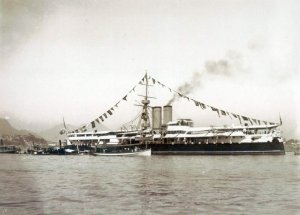
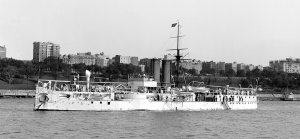
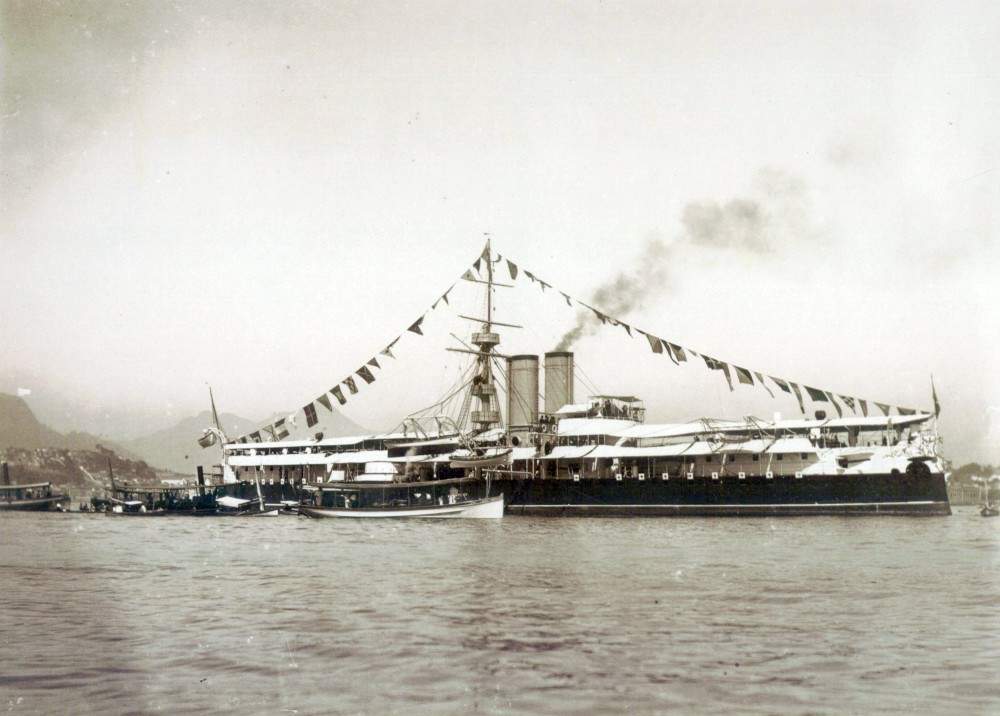
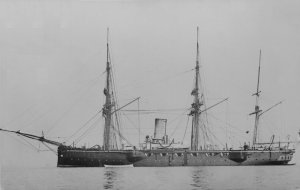
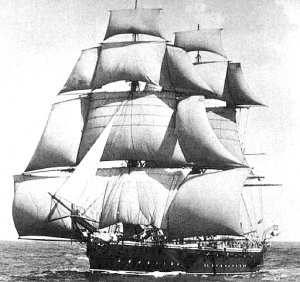
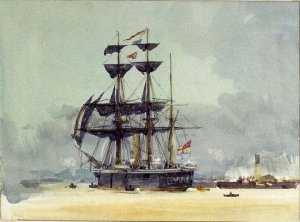
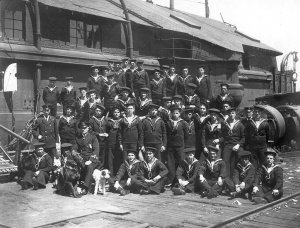
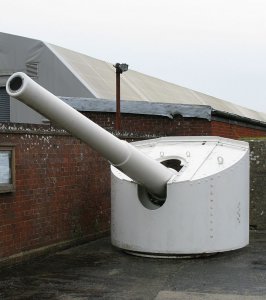
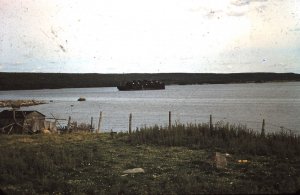
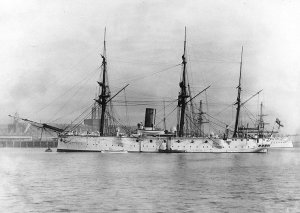
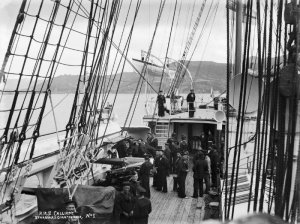
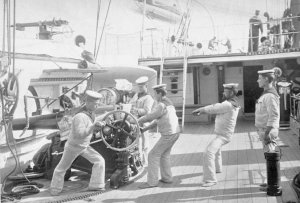
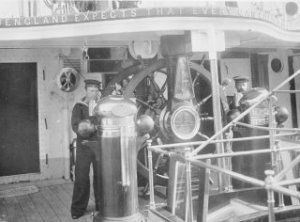

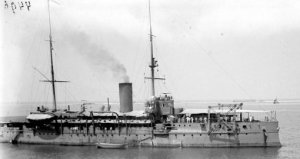



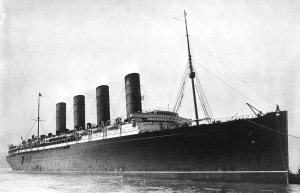
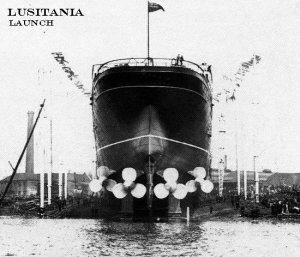
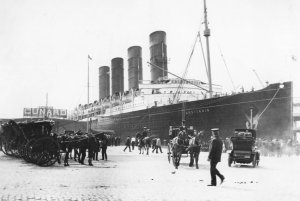

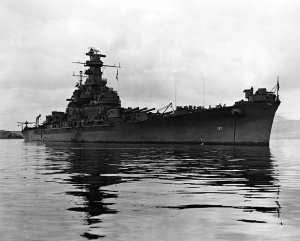

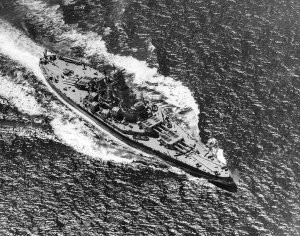
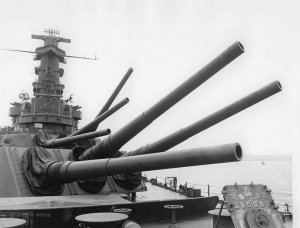



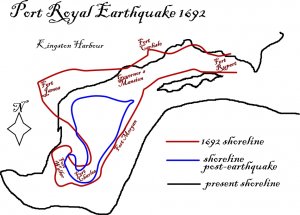

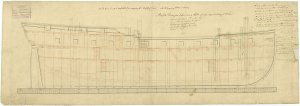


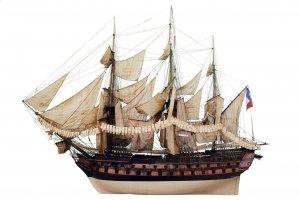

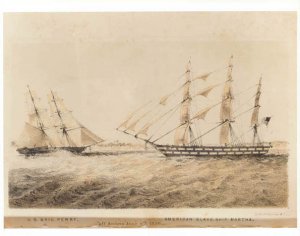

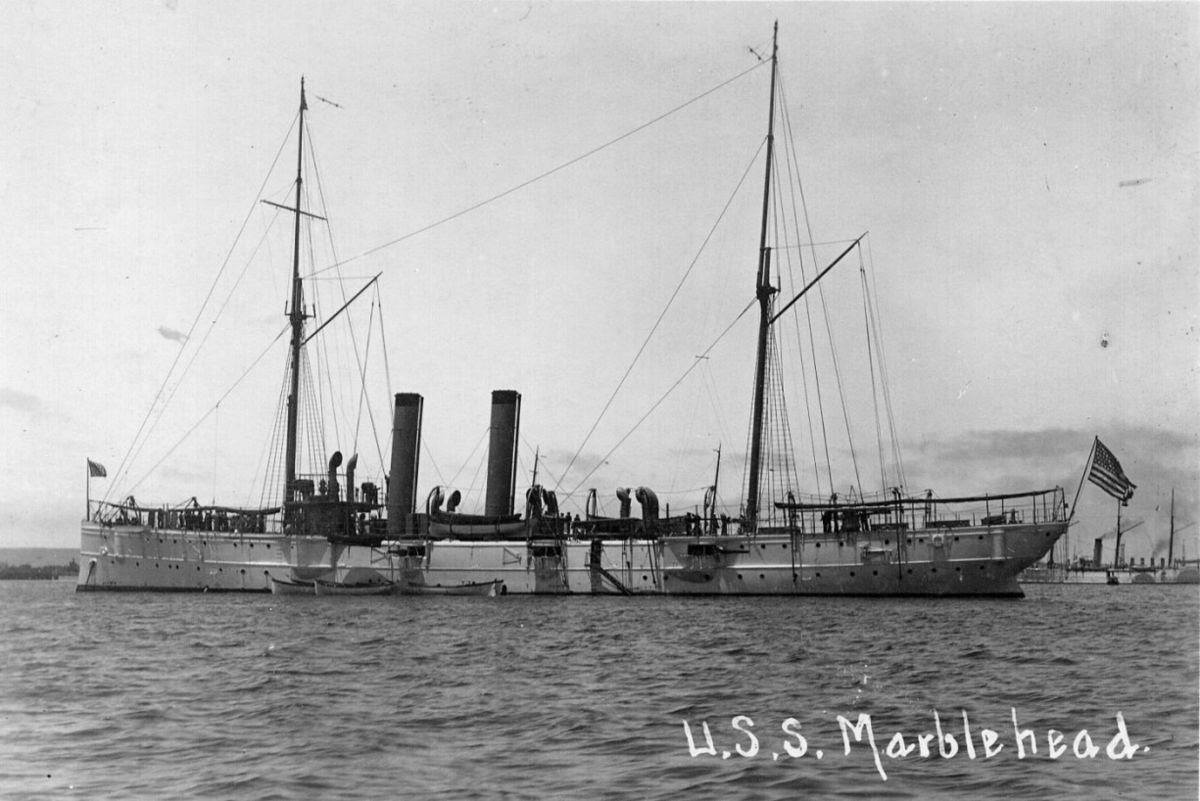

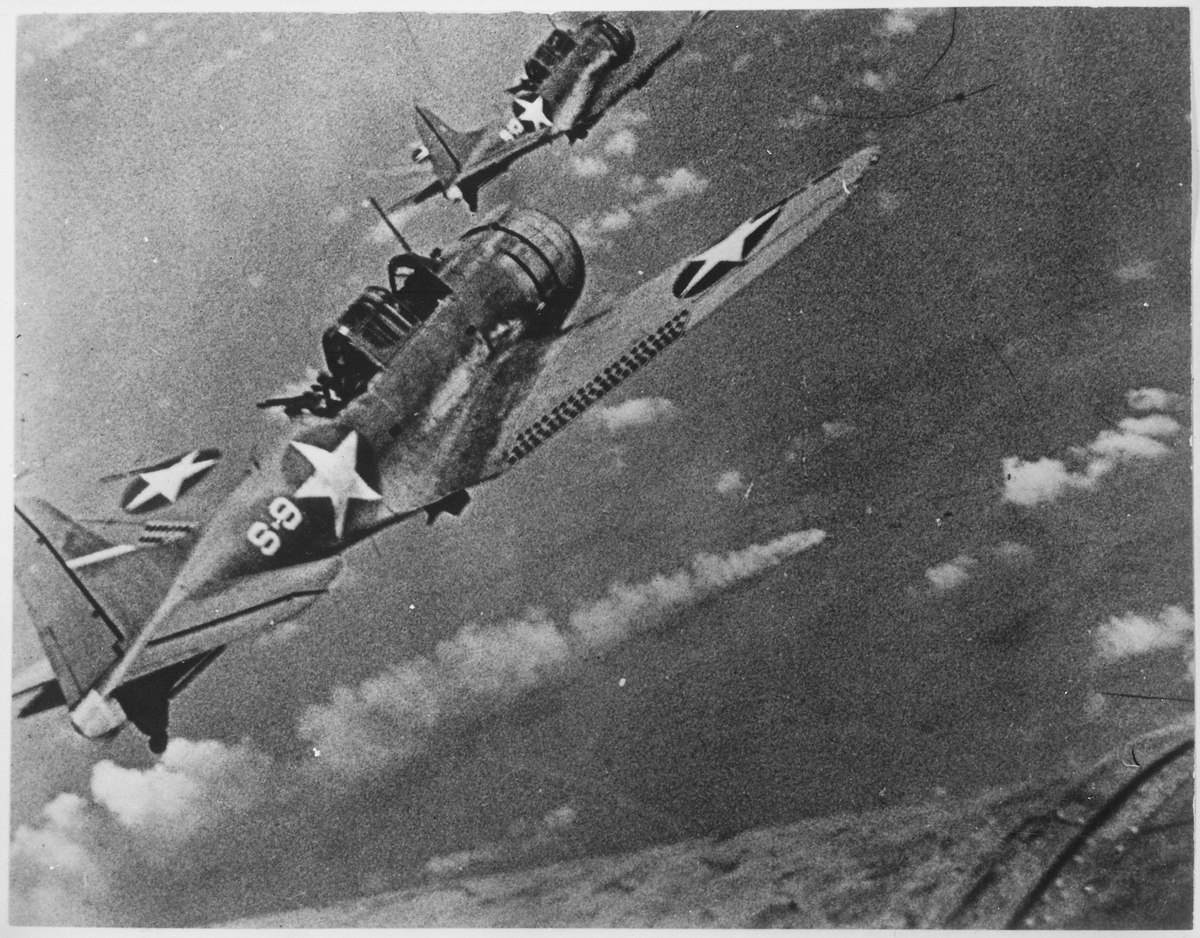
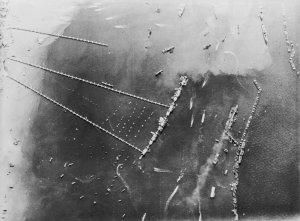
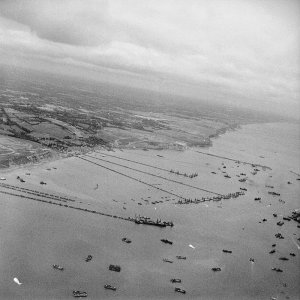
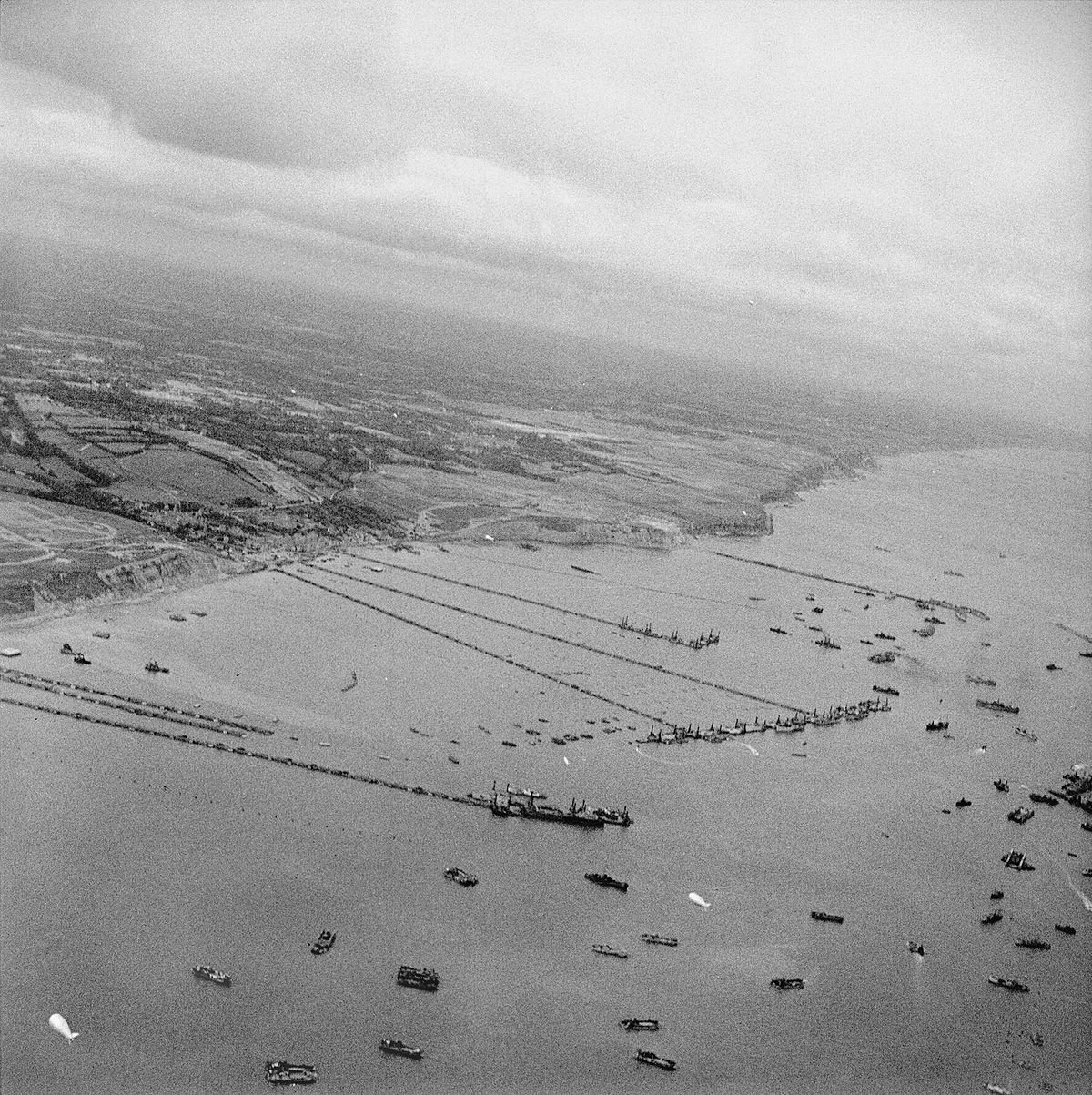
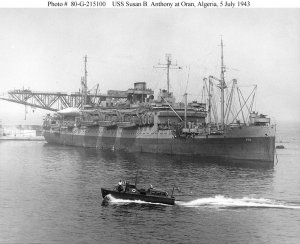
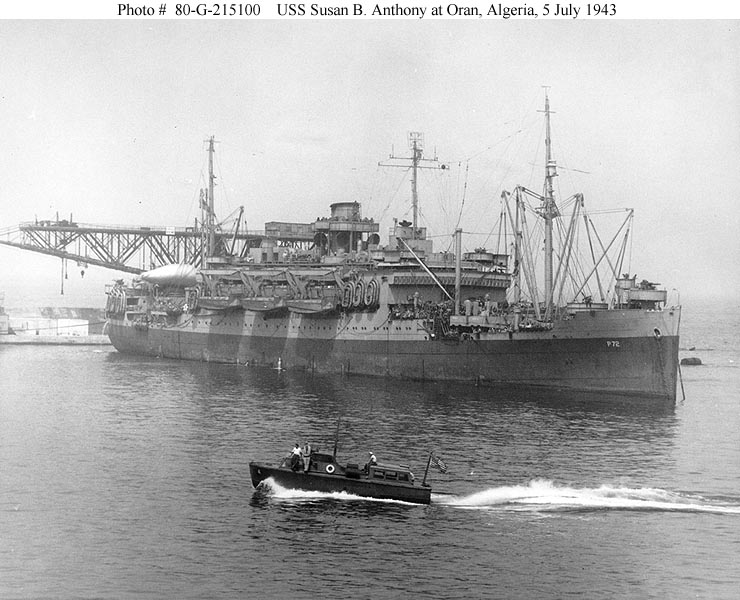
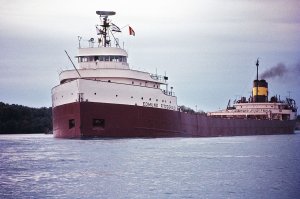
 week. The sinking led to changes in Great Lakes shipping regulations and practices that included mandatory survival suits, depth finders, positioning systems, increased freeboard, and more frequent inspection of vessels.
week. The sinking led to changes in Great Lakes shipping regulations and practices that included mandatory survival suits, depth finders, positioning systems, increased freeboard, and more frequent inspection of vessels.
